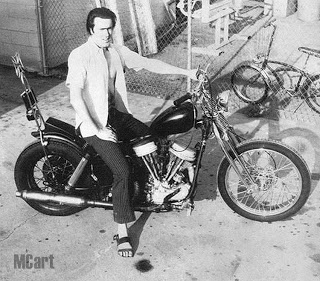“He’s not the way he draws. I’ve always questioned him on that-I say, ‘You draw all this crazy stuff, but you live such a sedate life. Why is that?’ I never could get a decent answer out of him.” – Ed “Big Daddy” Roth on Robert Williams (Hot Rod Magazine)
Robert Williams was born in Albuquerque, New Mexico on March 2, 1943, growing up in between his father who lived in Montgomery, Alabama and his mother’s home in Albuquerque. His father owned “The Parkmore,” a drive-in restaurant frequented by hot rodders. Williams himself received his first car, a 34 Ford 5 window coupe, at 12 years of age as a gift from his father.
 |
| Expectorating In A Fast Food Patron’s Double Burger Deluxe |
William’s youth was spent delinquently and immersed in hot rods and gangs, leading to his expulsion from school in the 9th grade for “habitual truancy and transgressions against the code of conduct”: involvement in local gangs also resulted in busts for public drunkenness and fighting.
“There wasn’t a real bohemian society in Albuqueque for me to follow. There were some people of that style that hung around college that were drug addicts and stuff. I was obviously going to get in a lot of trouble if I stayed in Alburqueque. I was trying to get an art education”.
“There wasn’t a real bohemian society in Albuqueque for me to follow. There were some people of that style that hung around college that were drug addicts and stuff. I was obviously going to get in a lot of trouble if I stayed in Alburqueque. I was trying to get an art education”.
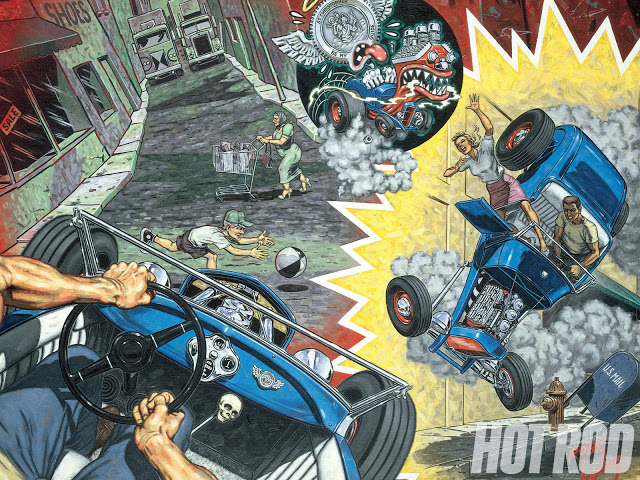 |
| A White-Knuckled Ride for Lucky St. Christopher |
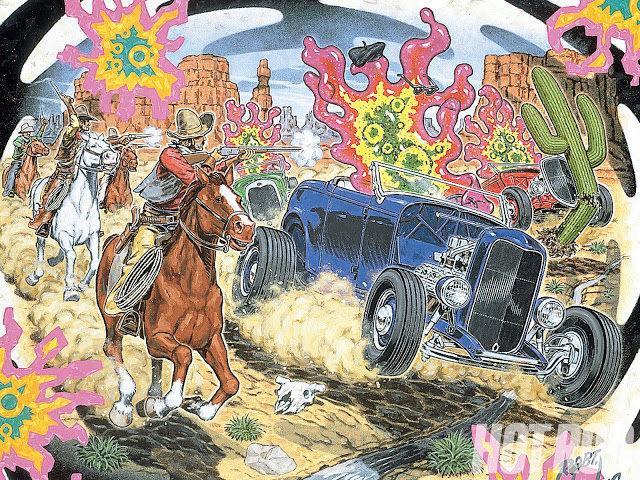 |
| Cowboys and Amoebas |
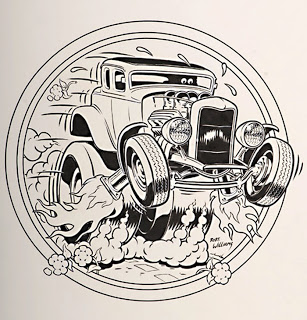 In an attempt to avoid jail he headed to L.A in 1963, taking classes at Los Angeles City College and contributing artwork to the school paper.
In an attempt to avoid jail he headed to L.A in 1963, taking classes at Los Angeles City College and contributing artwork to the school paper.After a series of failures in finding work, the manager of the local unemployment office offered him a job with a ‘freak’ called “Big Daddy”. Williams knew the name.
“They told me that the freak that ran it was some guy called Big Daddy and I said, ‘Wait a minute, would that be Ed Roth?’ They said it was, and I said, ‘Let me at it. I was born for this job”.
In Roth’s garage cars were created in a freestyle manner, and he did it faster, more effective, and in an unmatched style. This is where Williams got the inspiration and most of the ideas for his Low Brow Art. A steady stream of local culture passed through the shop- Williams says:
“Every day something amazing would happen. In the morning Sam the Sham and the Pharaohs’ recording group could walk in and few minutes behind them would be Sonny Barger and some Angels”.
“Every day something amazing would happen. In the morning Sam the Sham and the Pharaohs’ recording group could walk in and few minutes behind them would be Sonny Barger and some Angels”.
 |
| Blue-Collar Bravado Born of a Torque Wrench |
According to Ed Roth:
“When Robert came to work for me, he was pretty destitute,” remembers Roth. “He came in from New Mexico and showed me this stuff, and I thought, ‘Naw, this hippie kid couldn’t draw all this.’ So I told him, I says, ‘You go home and draw me a picture of a ’64 Plymouth in the weeds-and put a monster in it.’ And by golly, the next day he came back and had it. And it was just super.”
His true schooling came from Von Dutch and Roth in the mid-’60s, whose multidisciplinary approach blurred the distinction between machinists, car customizers, and artists.
“Von Dutch was the guy that gave soul and character to hot rods,” says Williams almost reverently. “He embodied a thing that’s gonna be passed on for another couple of centuries. And that is the way to take any kind of machinery-like a toaster, or a coffee machine, or a garbage disposal-and give it an essential soul. It’s exactly like American Indians getting a Springfield ’73 rifle, putting rawhide around it, putting brass tacks on it, and making it an ‘Indian gun.’ Once you’ve done that, you’ve given that machine karma. And Von Dutch had this ability. He could make an inanimate, cold, pragmatic thing spiritual.”
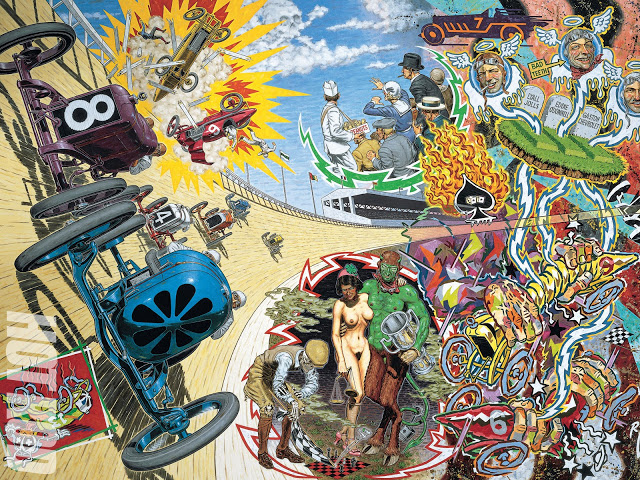 |
| Death on the Boards |
The early work consisted of creating monthly advertising, graphic design work, working on the elaborate hot rod projects (like The Rat Fink and Peace Fink) and occasional contributions to Roth’s Chopper Magazine. He worked with Roth for four years, but some of the off-kilter themes that would later become hallmarks of his work -nude women, nightmarish and absurd violence- began to find their way into the ads, and Roth had more than a few discussions with Williams about the company’s more mainstream intent.
“He sees me as a pornographer, and I see him as kind of a religious zealot. We’re very, very good friends, and he’s been like a father to me. But he still sees me as this unchaste person who misused his talent to hurt young people.”
“He sees me as a pornographer, and I see him as kind of a religious zealot. We’re very, very good friends, and he’s been like a father to me. But he still sees me as this unchaste person who misused his talent to hurt young people.”
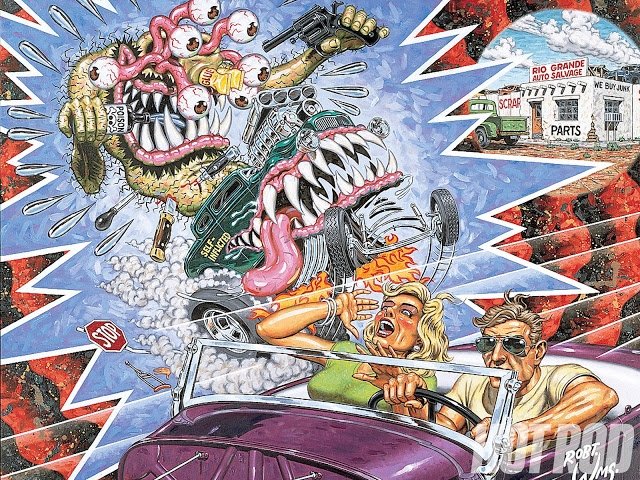 |
| Snuff Fink |
 |
| The Last Ride of the Purple People Eater |
Yet in an interview with Hot Rod Magazine, Roth was quick to point out Williams’ influence on the public perception of rodding:
“I think Robert’s mostly responsible for moving this whole thing into what I call the New York crowd to accept hot rodding as a genuine-I don’t know if it’s an art form-but as a genuine movement and culture.”
“I think Robert’s mostly responsible for moving this whole thing into what I call the New York crowd to accept hot rodding as a genuine-I don’t know if it’s an art form-but as a genuine movement and culture.”
 |
| Hot Rod Race |
Ed Roth closed up shop around the time Williams began drawing influence from the psychedelic poster art oozing down from San Francisco. He went to work on Zap Comix, but in 1970 he decided to eschew commercial work in favor of the fine arts, beginning an oil-painting regimen that has continued unabated since.
In the 1980s Williams caught the frenzied vibe of the punk rock movement and found his next audience. The “Zombie Mystery Paintings” were done quickly, on a rough canvas, and sold via a waiting list system due to demand.
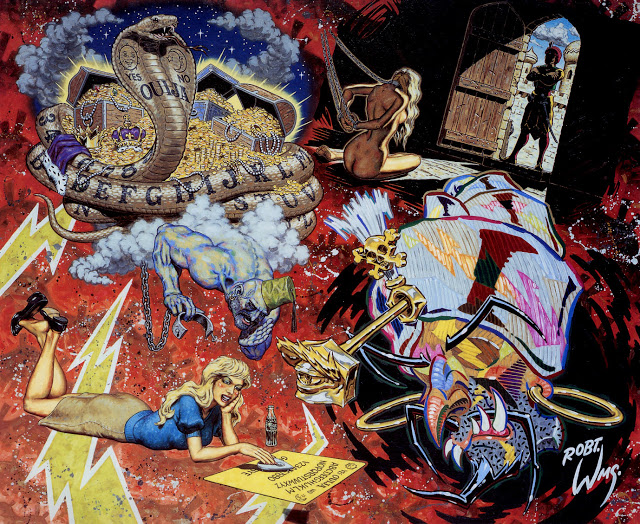 |
| The Voice From The Wee Gee Board |
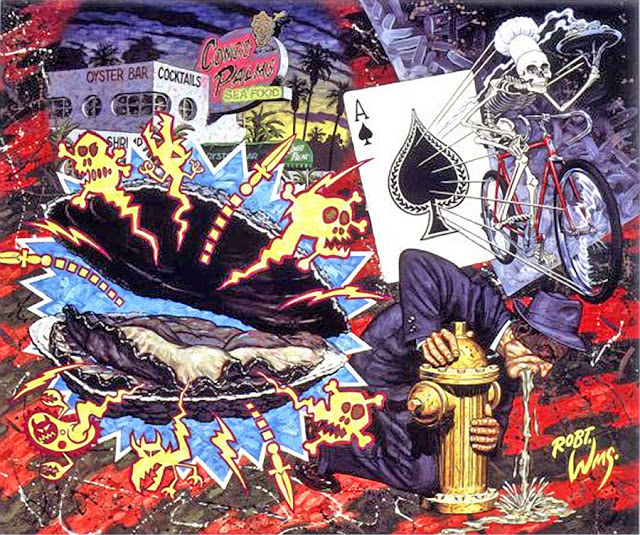 |
| The Day Joe Smiley Ate The Bad Oyster |
Popularity for Williams’ work was established in avant-garde galleries like Billy Shire’s La Luz de Jesus Gallery, Zero One Gallery, and the Tamara Bane Gallery. In 1994 Williams began JUXTAPOZ magazine which quickly became one of the highest circulated art magazines in the USA.
1997 saw the release of the to-date retrospective “Malicious Resplendence” as well as a one-man show at the Tony Shafrazi Gallery in New York. Two more Shafrazi shows followed in 2000 and 2003. In 2010 Williams was included in the Whitney Biennial at the Whitney Museum of American Art in New York , and a feature length documentary “Robert Williams Mr Bitchin’” was produced by Rhino Films / Foundation Films documenting Williams’ rise to fame from his car culture and underground comics roots.
 |
| Mathematics Takes a Holiday |
On October 9, 2010 Williams was awarded a lifetime achievement award as part of the Beyond Eden Fair in Hollywood California.
 |
| Appetite for Destruction |
References:
Zombie Mystery Paintings : Last Gasp of San Francisco, 1996


